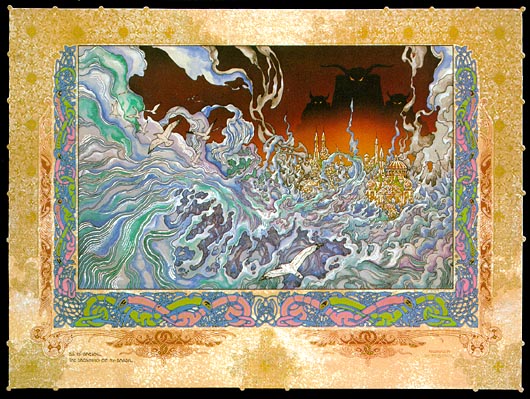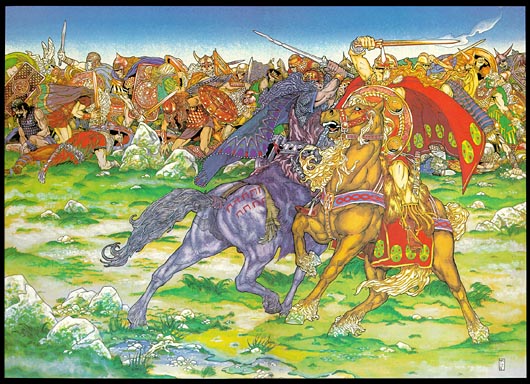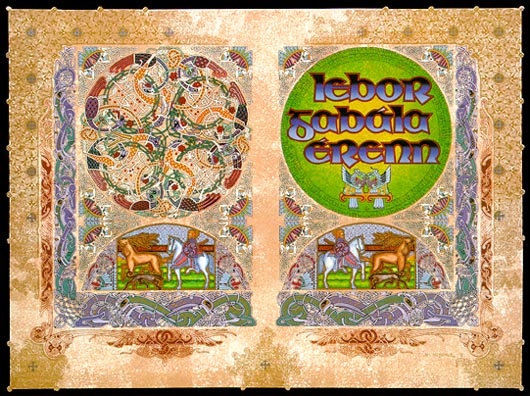“Know, oh prince…”: The “Nemedian” Chronicles?
Wednesday, February 25, 2009
posted by Deuce Richardson
 Print This Post
Print This Post
“Know, oh prince, that between the years when the oceans drank Atlantis and the gleaming cities, and the years of the rise of the sons of Aryas, there was an age undreamed of…”

That lead-in sentence from “The Phoenix on the Sword” is very easily one of the most memorable in the whole Conan canon. The entire paragraph that it initiates wouldn’t even exist without Farnsworth Wright’s editorial interference. Wright asked Robert E. Howard to take out much of the geo-political information contained in Chapter II of the “submitted draft” that was sent to Weird Tales. REH encapsulated that data (along with additional facts) in the “Nemedian Chronicles” epigraph for the first chapter of “The Phoenix on the Sword.” Robert E. Howard seems to have put more into that first sentence than might be apparent upon first glance…
“(B)etween the years when the oceans drank Atlantis” is straightforward enough. From all indications, the kingdoms of the Hyborians and their neighbors did flourish after “the oceans drank Atlantis.” However, “the years of the rise of the sons of Aryas” is problematic. If, as seems the case, “the rise of the sons of Aryas” refers to the expansion of the “Aryans” that REH describes in the almost-penultimate paragraph of the “Hyborian Age” essay, then, Belverus, we have a problem. A problem, that is, if we assume that the “Nemedians” of the “Nemedian Chronicles” were one and the same as the “Nemedians” of Conan’s era. How, exactly, would a “Nemedian chronicler” of Conan’s time (or any time until “the rise of the sons of Aryas”) know about said “sons of Aryas”? What “prince” is this “chronicler” tutoring in lore pertaining to undreamt-of times?
Could the “chronicler” in question have been a “Nemedian” from before the fall of the Hyborian Age, as has been assumed for all these years? How then, as noted above, could he prophecy the advent of the sons of Aryas? Why didn’t this far-sighted sage use his clairvoyant talents to avert the collapse of the Hyborian regime? More importantly, why would our hypothetical Hyborian Age-scholar-with-the-gift-of-prophesy even care about the horse-taming “sons of Aryas”? The “Aryans” that REH describes in “The Hyborian Age” essay were a melding of Nordheimr and Cimmerians. No Hyborian “Nemedian” blood pulsed through their veins. The sons of Aryas were heirs to the exact same red-handed killers that rang the death-knell for the end of Nemedia’s proud, millenia-spanning history.
Might a copy of “The Nemedian Chronicles” have been carried south (somehow) and been deposited and preserved in the (supposed) archives of Vanir “Egypt”? Once again, why? Why would those pragmatic (illiterate) reavers even care? From indications in the Conan yarns and “The Hyborian Age”, the Vanir (especially the “Egyptian” variety) had only passing encounters with anyone resembling a “Hyborian,” let alone a Nemedian. The final rulers of Nemedia were AEsir usurpers. The AEsir and Vanir were age-old foes. On the other hand, LS de Camp did once write that some of Conan’s exploits were preserved from pharaohonic times, so I guess such a theory has that going for it. Of course, we still have that precocious “sons of Aryas” passage to account for.
Perhaps the retreating Hyrkanians took a copy back into the blue East in their long retreat. Why they would do so is a mystery. Who would provide a translation? Non-Hyborophone Zamorans or non-Hyborophone Zingarans? Kushites, perhaps? Even if the Hyrkanians had a translator, what prophet-slave snuck in the “sons of Aryas” mention? Just as in the case of the hypothetical Hyborian Age chronicler, what would be the motive to even use the “rise of the sons of Aryas” as a line of temporal demarcation?
In days gone by, I’ve heard the argument that perhaps “the sons of Aryas” doesn’t even refer to the “Aryans” mentioned in “The Hyborian Age” essay. On top of the fact that “Aryas” and “Aryan” differ in only one final consonant, we also have the highly similar phrase, “the sons of Aryan,” from “The Valley of the Worm” and “The Children of the Night.” In the context that Howard presents it, that phrase indubitably refers to the same “Aryans” that he mentions in so many other yarns. There is also the proto-Celt/”Aryan”, Aryara, in REH’s “The Children of the Night.” If the “sons of Aryas” referred to are not synonymous with the “sons of Aryan,” exactly who might they be? In order to (clumsily) accomodate a “Hyborian Nemedian” paradigm, the “sons of Aryas” could only be either Nordheimr, Cimmerians, Picts or Hyrkanians. “Aryas” seems to be a name that is native to none of them, if Howard’s name-lists and yarns are any guide. The “sons of Aryas” would appear to be the “Aryans” from the “Hyborian Age” essay, an amalgamation of Cimmerians and Nordheimr from which a name like “Aryas” might arise.

If not a “real Nemedian,” who else could be our “chronicler”? Robert E. Howard provides plenty of clues. First and foremost, we know from the “Hyborian Age” essay that the ethnically “Hyborian” Nemedians of the Hyborian Age were not the “only” Nemedians. A cadre of AEsir widow-makers took over the defense of Nemedia in its last days. They took over the name of “Nemedians” as well. Reeling from successive assaults by Cimmerians and fellow Nordheimr, the Nordic “Nemedians” (“to whom the term Nemedians henceforth refers,” according to REH) made a fighting retreat into Koth. They don’t seem to have moved on to the Vilayet/Caspian as their AEsir kin did. Eastern Koth occupies the same geographical location as Greece, Asia Minor and southern Scythia. Howard states that, “The Nemedians of Irish legendry were the Nemedian AEsir.” Irish legendry states that the followers of Nemed, the “Irish Nemedians,” came from Scythia. After a sojourn in Eire (according to the Lebor Gabala Erenn), some of the sons of Nemed were stranded in Greece, slaves in shackles. They would return to Ireland as the Fir Bolg and make Connacht their own.

As Robert E. Howard might say, we have now “come within the reach of modern history,” and the tale of how the “Nemedian Chronicles” (might have) found their way into our own decadent times will have to wait for Part Two.
